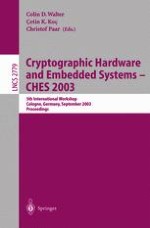2003 | Buch
Cryptographic Hardware and Embedded Systems - CHES 2003
5th International Workshop, Cologne, Germany, September 8–10, 2003. Proceedings
herausgegeben von: Colin D. Walter, Çetin K. Koç, Christof Paar
Verlag: Springer Berlin Heidelberg
Buchreihe : Lecture Notes in Computer Science
Enthalten in: Professional Book Archive
